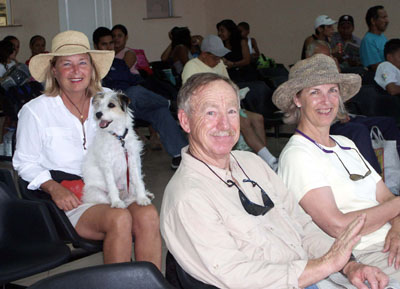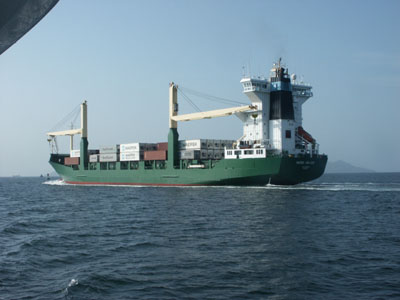
Tina our agent was totally on top of things. She got all our papers and passports back to us on time and with no problems. She arranged to have the rental ropes for the canal transit delivered and threw in a couple tires for extra padding to put on the side of the boat. Some people thought Tina was pushy but we thought she did a great job. I think you have to be pushy trying to get all the things done on time like she does. We were right on schedule, until two nights before the departure date.
I awoke at midnight and heard an alarm going off in the
wheelhouse. It was the alarm for the stabilizers. After reading the manual,
and not finding a solution, Larry called the stabilizer guy on the satellite
phone. The stabilizer guy thought the problem was just a display panel failure,
so Larry had him Fed Ex one to us in Panama. Tina gave us instructions how to
have it addressed to get it through customs as fast as possible. She would pick
it up and bring it to us as soon as it arrived. Larry delayed the departure for
the canal transit two days so we could get the part and hopefully this would be
the problem.
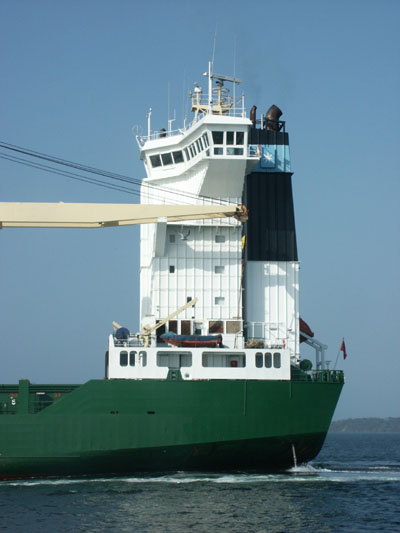 Tina insisted we delay because she said we would be better off
getting delayed and stuck in Panama rather than Colon because it’s not a nice
place to be.
Tina insisted we delay because she said we would be better off
getting delayed and stuck in Panama rather than Colon because it’s not a nice
place to be.
So we started the waiting game at the Balboa Yacht Club. We watched the freighters coming and going in and out the passage to the canal. They were huge massive things. Their wakes really weren’t bothersome even though they passed right beside us. I did worry a little about one of them hitting us in the middle of the night. The most troublesome wakes were from the pilot boats as they sped by with no regard. Freighters from all over the world would pass by with loads of cars, fuel, grains, whatever you could imagine. It was non-stop. We would see a few boats like ours, cruisers, leaving early in the morning for their transit and then others coming out of the canal from the Caribbean at the end of the day. The ones coming out were loaded with fenders and the crews looked tired and worn. They motored around the marina looking for moorings to pick up. You could also tell which boats were going out soon, like ours, as they were ready with their fenders and tires all secured on one side of their boat. The tires are merely old car tires that have been wrapped in black plastic trash bags and the plastic bag is taped with brown packaging tape like a candy cane. They were recycled from one boat to the next. Everybody used them. You get them on one end and dropped them off at the other end. Same with the long huge ropes that we would use to secure the boat inside the locks. You rent them, used them and dropped them off on the other end. I wondered how many times our lines and tires had been used and on what kinds of boats.
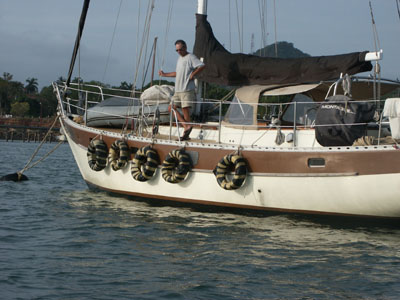 Our huge lines were delivered on our deck when we were
out. Tina had also dropped off our final papers. Now it was just a waiting
game to see if the part Larry needed was going to fix the problem or if we had
to fly down a technician from the states. There was no one in Panama with the
knowledge or was qualified to work on these stabilizers.
Our huge lines were delivered on our deck when we were
out. Tina had also dropped off our final papers. Now it was just a waiting
game to see if the part Larry needed was going to fix the problem or if we had
to fly down a technician from the states. There was no one in Panama with the
knowledge or was qualified to work on these stabilizers.
Dave Wyman, having gone through the canal several times,
was our guru. He divided the lines up and placed one at each corner of the
boat; two at the bow on each side and two at the stern, each side. He then tied
a bowline on the end of each line. The bowline was about 18” diameter. He said
this was the knot required that would provide the loop to thread the monkey fist
that the line handlers from the canal would throw at us. He showed us how we
would thread the line with the monkey fist so the line handler could then pull
the huge line back. 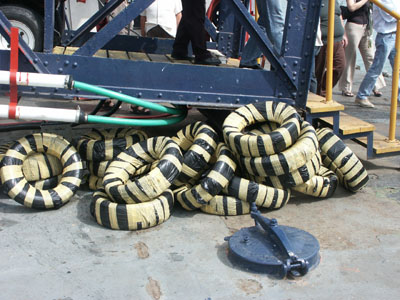 As they pulled the line back, he showed us how to keep the
line loose but semi-cleeted to keep the boat steady. He told us how to let out
enough as the boat moved down in the lock and how to draw it in when the boat
went up in the lock. He told us we would have to ready at any moment to quickly
cleat the line tight to hold the boat in a secure position as it might be
thrusted with the strong currents or water thrusting from other boats or tugs.
Dave said as the boat would come up in the three locks on the Pacific side and
would go down in the three locks on the Atlantic side. He said as water flowed
into the lock we would need to loosen the line and readjust the tightness and
vice versa on the other side. As we reached the highest level on Lake Gatun, we
would have a few hours to rest. This whole process was going to take from 8-10
hours if we didn’t have to anchor in Lake Gatun for the night and pick up on the
last three locks the next morning.
As they pulled the line back, he showed us how to keep the
line loose but semi-cleeted to keep the boat steady. He told us how to let out
enough as the boat moved down in the lock and how to draw it in when the boat
went up in the lock. He told us we would have to ready at any moment to quickly
cleat the line tight to hold the boat in a secure position as it might be
thrusted with the strong currents or water thrusting from other boats or tugs.
Dave said as the boat would come up in the three locks on the Pacific side and
would go down in the three locks on the Atlantic side. He said as water flowed
into the lock we would need to loosen the line and readjust the tightness and
vice versa on the other side. As we reached the highest level on Lake Gatun, we
would have a few hours to rest. This whole process was going to take from 8-10
hours if we didn’t have to anchor in Lake Gatun for the night and pick up on the
last three locks the next morning.
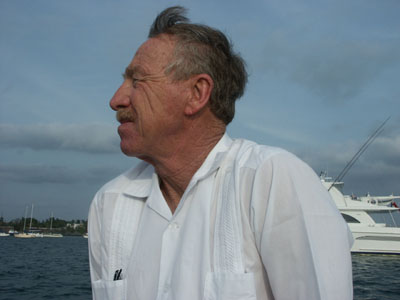 We all practiced our knots so we’d be ready
to secure the monkey fists and Dave was busy hanging our tires and fenders off
the side of the boat making sure we had enough lines to suspend the tires, and
he made sure the fenders were place correctly to protect the sides of the boat.
We also loaded the refrigerator with cokes, as it was the custom to toss the
canal line handlers a coke in each lock. That was going to require several
cokes.
We all practiced our knots so we’d be ready
to secure the monkey fists and Dave was busy hanging our tires and fenders off
the side of the boat making sure we had enough lines to suspend the tires, and
he made sure the fenders were place correctly to protect the sides of the boat.
We also loaded the refrigerator with cokes, as it was the custom to toss the
canal line handlers a coke in each lock. That was going to require several
cokes.
Our canal agent had asked us what scenario we would prefer as we go through the locks. We had requested a center tie or to be tied to a tug as those were the safest and we would have the least chance of damaging the boat. We requested not to be tied to the wall, which is the least desirable option because the boat can get damaged against the rough concrete walls. A center tie would mean we would be tossing our lines to the canal line handler from all four corners of the boat and we would be adjusting constantly. If we were tied to a tug or another boat, we would be rafting to the other boat and would only have to handle lines on one side of the boat. That would be a bowline, stern line, and two spring lines at the center. We would raft up tightly and hold it constant until the lock was full or empty and then we would release and repeat the scenario on the next lock. Dave assigned me to the stern, Richard to the bow and he would be at the center doing the springs. Not sure what Margie was doing. Larry would run the boat with our canal pilot giving him instructions.
CLICK ON ANY PHOTO
TO ENLARGE
|
|
In the meantime, we spent the days watching the world go round and running quick taxi rides to the Rey or Super 99 (super markets on the other side of town) to get provisioning items. Richard’s main item was ice cream and the freezer was about full of ice cream, Dreyer’s to be exact and big French rolls, which took a lot of freezer space. It had priority over eggs and bread or paper towels. I preferred actually to stay on the boat because I couldn’t stand the heat anymore. We also made a trip to the old Panama City and Islas Tabogas while we waited.
Cruisers moored at the Balboa YC were not allowed to bring
their dinghies ashore for security reasons. The YC provided a couple crude
launches to pick you up on your boat and deliver you to their fuel dock. You
had to hail them on the radio on channel 16, calling “muelle, muelle, muelle,
Knotty Dog, Knotty Dog”. This translated to “pier, pier, pier, Knotty Dog,
Knotty Dog” which meant we needed a pick up. You might have to repeat this
about 4 times before you got a response in some funny kind of Spanish that I
didn’t understand. I’d just repeat “Knotty Dog, Launch” and pretty soon the
launch would be pulling out to pick you up. The launches were like a
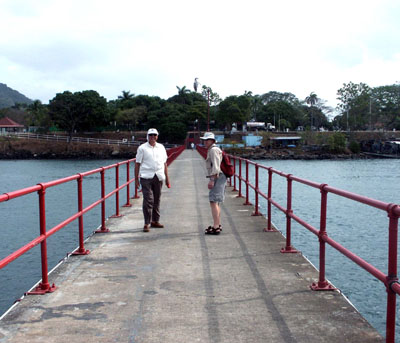 long ponga
with a huge loud engine in the center of the boat that was partially enclosed. The launch driver sat in the back with a large handle steering the launch. The
engine was so loud nothing could be heard above the roar of the engine so
everyone would pretty much sit quietly as he drove from boat to boat picking up
and dropping off boaters such as us. Some had bags of groceries, or bags of
trash, and others had dogs like us that they were taking to shore. You never
said a word to the launch driver because he couldn’t hear over the engine
noise. You just pointed to your boat. They are very quick to put your face
with your boat and after the first day we no longer had to point to our boat, he
just knew and took us there. It also helped for the launch driver to remember
which boat was ours since Larry would give him a dollar tip each way, though not
required.
long ponga
with a huge loud engine in the center of the boat that was partially enclosed. The launch driver sat in the back with a large handle steering the launch. The
engine was so loud nothing could be heard above the roar of the engine so
everyone would pretty much sit quietly as he drove from boat to boat picking up
and dropping off boaters such as us. Some had bags of groceries, or bags of
trash, and others had dogs like us that they were taking to shore. You never
said a word to the launch driver because he couldn’t hear over the engine
noise. You just pointed to your boat. They are very quick to put your face
with your boat and after the first day we no longer had to point to our boat, he
just knew and took us there. It also helped for the launch driver to remember
which boat was ours since Larry would give him a dollar tip each way, though not
required.
The launches were rustic and quite worn and the engines
were slow. You couldn’t wear nice clothes because the bench where you sat was
also where everyone stepped onto the boat. It was dirty and the seat of your
pants was usually dirty after your ride. So forget going anywhere nice. The
launch driver was pretty good about getting the launch bow pointed up to our
swim step and hold it there just long enough for us to jump out or on, even in swelly conditions without hitting out boat. He’d come within an inch, even
though he was seated about 20 feet away.
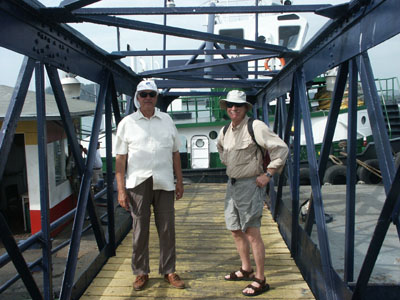 I don’t know how he saw what he was
doing.
I don’t know how he saw what he was
doing.
The drop off point, at shore, was on the grimy dock at the
end of a looooong pier, which also served as the fuel dock. There was nothing
attractive about this place. You then had to walk the long pier to get to the
shoreline and when you had bags full of groceries, trash or whatever it seemed
never ending. We fueled the boat up at the Balboa YC dock and it took hours,
literally. There was so much air in their fuel line that our fuel intake valves
were burping out the fuel nonstop. We tried to give the boat a semi-wash-down
or bath with the water on the fuel dock while we were filling up. The water
came out of a 2” diameter hose that was crudely cut off, so you couldn’t attach
a nozzle. We got the boat about halfway done and the fuel dock guy yelled at us
that we couldn’t wash the boat anymore and abruptly turned the water off. I had
to talk him into letting us finish rinsing since we had the boat soaped up. We
had been so crusted with salt that when you’d walk around the boat it would
literally get on your clothes like crusty icing. I was desperate to get it off,
as it was everywhere, windows, railings, and decks. We did our best to get a
quick rinse before he cut us off. The fuel was a $1.75 a gallon here, quite a
bit cheaper than the last fuel stop in Los Suenos.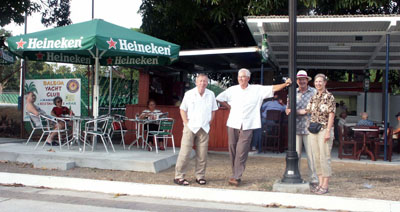
The bar at the yacht club, as I mentioned earlier, amounted
to a simple concrete slab and make shift bar. The furniture consisted of
plastic chairs and tables. Though rustic and no atmosphere and really nothing
to offer but a place to sit and a warm beer, It would be filled with cruisers
from all over the world. They were all pretty much just sitting it out, waiting
for their turn. The cacophony of different languages was spell binding. The
surprising thing to me was the rusticity of this place considering the 1000’s of
boats passing through here every year. I guess I expected more. Nothing was
easy for the cruiser here. Food was a long way away, and not easy to get to.
The services for showers and toilets were slim at best, as the clubhouse burned
downed a few years ago, and they put up a make shift toilet and shower in a
portable trailer.
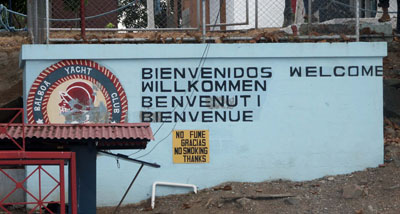 This must be difficult for many boaters who depend on shore
services for their showers and toilets while moored for any length of time. We
were more fortunate as we had a good bit of water to shower, wash dishes, and
use in our toilets. It would have helped if Richard wouldn’t have let the water
run non-stop whenever he did anything at the sink. He just couldn’t get it in
his head how precious water was on the boat and how much energy it took to make
it. He thought it was no big deal to just make water whenever we needed it. I
tried to explain to him that we would only make water in pristine conditions not
in any area where the water supply was questionable. Not sure what he was doing
in the shower but I’d bet it was more of the same. Anyway, we bit the bullet
and had to make the water there. We had previously only been doing it in areas
where we knew the water was really clean. We had kept our water tanks pristine
but now had no choice. When we filled the tank, Larry cleaned the filter and it
was filthy.
This must be difficult for many boaters who depend on shore
services for their showers and toilets while moored for any length of time. We
were more fortunate as we had a good bit of water to shower, wash dishes, and
use in our toilets. It would have helped if Richard wouldn’t have let the water
run non-stop whenever he did anything at the sink. He just couldn’t get it in
his head how precious water was on the boat and how much energy it took to make
it. He thought it was no big deal to just make water whenever we needed it. I
tried to explain to him that we would only make water in pristine conditions not
in any area where the water supply was questionable. Not sure what he was doing
in the shower but I’d bet it was more of the same. Anyway, we bit the bullet
and had to make the water there. We had previously only been doing it in areas
where we knew the water was really clean. We had kept our water tanks pristine
but now had no choice. When we filled the tank, Larry cleaned the filter and it
was filthy.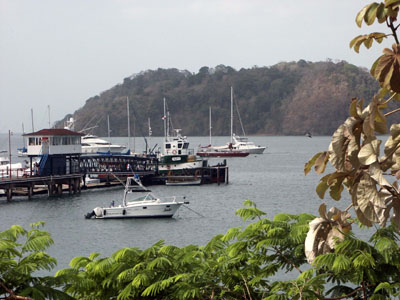
The Flamenco Yacht Club, which is located at the outer entrance to the canal, is a more upscale marina. We couldn’t get in there because they were full. That marina is still under construction but has some docks with power and water. The big powerboat had all the available slips occupied. There are several restaurants and a few stores nearby, which are nice, and we ate there a few times. They are also set up for cruise ships with duty free stores. If you are anchored out, you can bring your dinghy in for a slight charge but the dinghy dock is not convenient or easy. We had a great Italian dinner at the marina one night, called Alberto’s. It was the best meal since we entered Panama.
The day before our scheduled departure, we received our
replacement part for the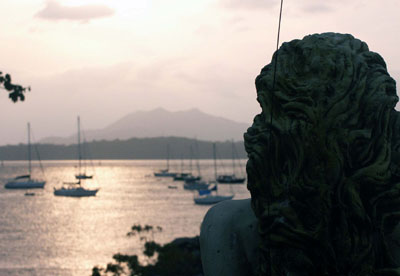 stabilizers right on schedule. Tina has been great
getting things done and got the part to us right away. Larry installed it and
“bingo” we were back in action again! We got word that our departure was
scheduled for 7:45 AM the next morning. So now, we were in gear for the
crossing, and the excitement was building. To read about our trip to ISLA
TABOGA click
ISLA TABOGA
stabilizers right on schedule. Tina has been great
getting things done and got the part to us right away. Larry installed it and
“bingo” we were back in action again! We got word that our departure was
scheduled for 7:45 AM the next morning. So now, we were in gear for the
crossing, and the excitement was building. To read about our trip to ISLA
TABOGA click
ISLA TABOGA